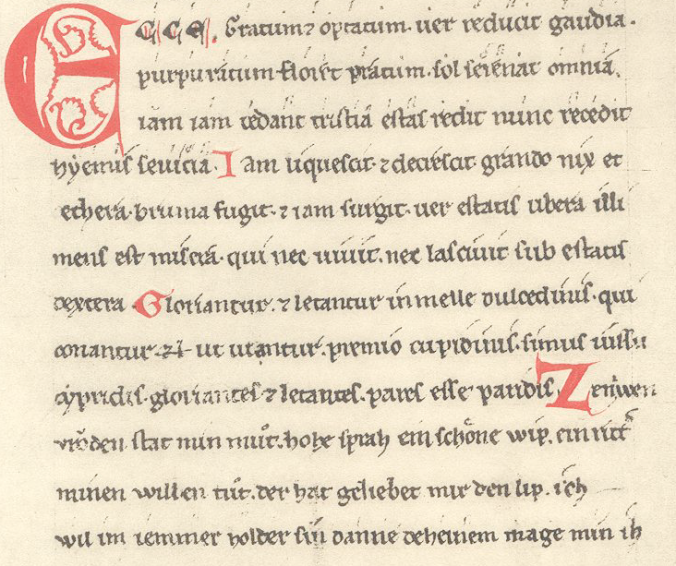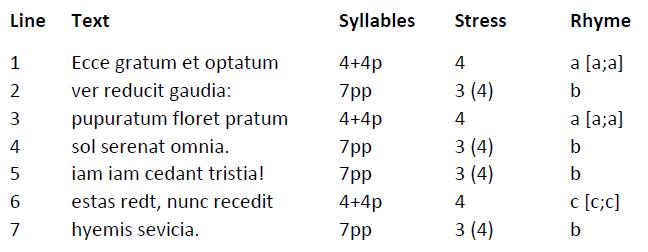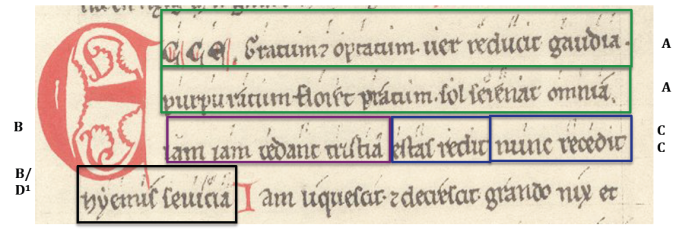Last week Catherine Bradley and I gave a joint presentation at the University of Oxford Medieval German Seminar, titled ‘Getting Music Into and Out Of the Codex Buranus’. The Codex Buranus, or the Carmina Burana (i.e. the songs of the Codex Buranus), has been the subject of investigation for the seminar this term, and while the group is principally comprised of literary scholars, Dr Almut Suerbaum was kind enough to invite a number of musicologists along to help establish the texts not only as texts but as songs.
Now the first thing that comes to mind when thinking about the Carmina Burana is most often the overwhelming setting of some of its poems by twentieth-century composer Carl Orff, including the memorable chorus ‘O Fortuna’. Given the nature of my blog, you may not be surprised to learn that Orff wasn’t the focus of our presentation though! Orff simply set to music a selection of texts from the thirteenth-century Codex Buranus (dated around 1230) which gets its name from being held at the monastery of Benediktbeuern in Southern Germany before it was moved to the Bayerische Staatsbibliothek in Munich. The manuscript contains texts in Latin and Middle High German, ranging from love songs to drinking songs, to satire, and some very bawdy songs.
The codex hasn’t received much attention from music scholars, however, mainly because of its problematic musical notation. The manuscript uses un-heighted or adiastematic neumes—in other words, it uses lots of perplexing little squiggles that aren’t placed on the lines of a stave and which seem to give no precise information about the pitch or rhythm of the melodies.
As Catherine and I explored in more detail, scholarship has relied instead on music that survives for some of the Carmina Burana poems in later, more precisely notated sources, in order to reconstruct the music of the Codex Buranus. But what about songs for which no musical notation survives elsewhere? Can we get any information from the notation in the Codex Buranus itself?
One of the texts famously set by Orff, Ecce gratum (CB 143) offers a particularly nice example of the way in which scholars can interpret musical structure in the Codex Buranus without knowing any precise musical details of pitch and rhythm.
This is what the piece looks like in the manuscript (which can be found online as part of the Petrucci Music Library IMSLP).
CB, fol. 59r,v:
The song consists of four stanzas, three of which are in Latin, and a final stanza in German. Musical notation is provided (as you can see above) only for the first Latin stanza and the very end of the German one.
Here is a transcription of the first stanza’s Latin text showing syllable counts, rhyme scheme, and stresses:
Looking at the patterns of the neume shapes in this annotated facsimile below, some clear musical repetitions emerge:
The neumes for the first two lines of text, ‘Ecce gratum et optatum, ver reducit gaudia’, are identical to those for the second couplet: ‘purpuratum floret partum, sol serenat omnia’. We’ve labelled this music ‘A’.
But as you can see there’s new musical material, which we’ve labelled ‘B’, for ‘iam iam cedant tristia’.
This is followed by a short new phrase, C, which is set to both ‘estas redit’ and ‘nunc recedit’.
The final line ‘hyemis sevicia’ has new music—but it is not as straightforward to make out whether this is completely new material, in which case it should be labelled ‘D’, or if this phrase might be a variation of the ‘B’ music, a sort of ‘B1’.
Thus the musical structure and the poetic structure complement each other very nicely:
This mini analysis already shows impressively that, even if we can never know what these songs really sounded like, or to what pitches or rhythms they were sung, the Codex Buranus can still be a very important and useful source of musical evidence: it has a wealth of information to offer, particularly concerning music-text relationships. As this tantalisingly suggests, a proper in-depth study of music in this manuscript will transform current understandings of medieval vernacular song: an undertaking which Catherine and I are both very excited about and hope to undertake some time in the near future!





Could you turn the argument the other way round? These are songs, so why should it be at all surprising that they are also shaped and articulated melodically? What do you suggest the other options would be? Through-composed? Sequence-like?
Latinists seem reluctant to understand even the texts that survive in other sources as songs. David Traill has done the very usefull translation with commentary for Dumbarton Oaks: Carmina Burana, ed. and translated by David A. Traill, Harvard University Press: Cambridge MA, London, 2018 2vv) Yet his note for the pastorella (CB90) ‘Exiit diluculo’ (i. p. 549) argues that since the third stanza violates the syllabic and stress pattern of the first two, it must be a later addition. While not arguing about whether it was part of the poem originally or not, it would have been good to take into account the musical setting of its sacred counterpart in Los Hueglas fol. 93r-v. With no good reason, Traill chooses to reject Dronke argument about the secular text in Carmina Burana fitting the music far more neatly (explicitly with the so-called solecisms in the last stanza) than its sacred contrafactum. To me this is simply a failure to acknoweldge that much of what we’ve got in CB should first be categorised as songs and then as lyric poetry.